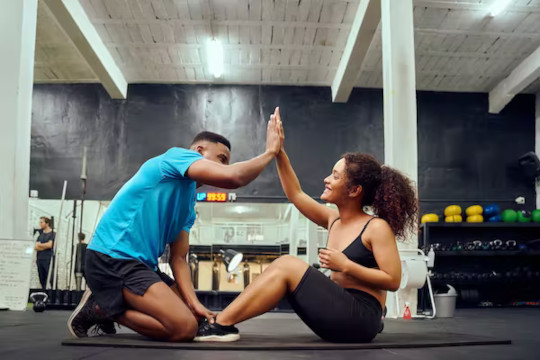
Muscle memory explains why it can feel quicker to get in shape after a gym break. StratfordProductions/ Shutterstock
Whether it’s riding a bike, playing the piano or hitting a hole in one, there are just some things you never forget how to do. And the reason for this phenomenon is thanks to something called “muscle memory”.
Muscle memory applies to a wide range of physical activities, from playing an instrument to sports. But though we need to practice a movement repeatedly in order to develop muscle memory, the term doesn’t actually refer to the muscles’ ability to remember movements. Rather, this “memory” happens in our central nervous system – which explains why many of us can retain skills we learned in childhood, even if we haven’t used them in years.
But muscle memory doesn’t only apply to skills and physical movements. It turns out that muscle memory can help us in the gym – especially if you’re trying to get back in shape after time off.
Two types of muscle memory
The first type refers to our ability to perform physical tasks automatically and easily. By practising a movement repeatedly, it allows you to perform those movements in a more automatic way, without needing to think very much about doing it. This is why athletes will practice a move or specific shot repeatedly, so they can perform it quickly and accurately during the pressure of competition.
Get The Latest By Email
At a basic level, this type of muscle memory involves the development of neural pathways which helps our brain communicate with our muscles more effectively. This occurs through a process called myelination, in which the myelin sheath (an insulating layer which surrounds nerve fibres) becomes thicker and more efficient at conducting electrical signals in both the body and brain.
Studies show myelination is enhanced through repeated practice of a physical task. Even relatively brief periods of practice can lead to significant changes in the brain and body that support the development of muscle memory.
But it’s important to note that not all repetition leads to muscle memory. It only happens when you engage in deliberate practice – meaning you perform specific movements or activities with focused attention and effort.
Back to fitness
The second type of muscle memory applies to our ability to get in shape.
Let’s say you were someone who, until recently, had never lifted heavy weights at the gym. You probably remember how awkward and difficult these exercises felt when you first started, and how it took a lot of gradual work to build your way up to lifting heavier weights.
Now let’s say you took a break from working out and returned many months later. You might have found that despite the time off, it was quite easy to return to the weights you were lifting before.
This is because of muscle memory. It applies to any exercise you perform, and can make it easier to regain lost muscle mass compared to when building muscle the first time.
The mechanisms behind this type of muscle memory aren’t fully understood. But our current theory is that even as muscle shrink, muscle cells remain.
In order to build muscle, they need to be placed under stress – for example, when doing exercises such as weight lifting. This stress triggers muscle cells to grow, helping us to become stronger.
For a long time, it was believed that if you don’t use your muscles, these new cells would die off. But research suggests this may not be the case, with a 2016 study finding that myonuclei (a part of the muscle cell which contains genetic information, and also acts as a key indicator of muscle growth) actually only shrink down when we’re inactive – they don’t disappear at all. While more research is needed to help us fully understand this process, this does at least suggest that our bodies use myonuclei to bank our capacity for fitness – which would explain why it’s faster to get fit the second time around.
But if you’re wondering how long it will take for you to get back in shape after a break from training, unfortunately that isn’t quite so easy to answer and will vary from person to person.
The rate at which muscle is regained can also depend on the level of inactivity you’ve had during your break from training. For example, it may take longer to get back into shape if you’ve been bedridden for months compared to if you simply stopped resistance training but continued with normal daily activities.
In the latter case, one study in women showed that even after more than six months off, participants were able to regain their pre-break muscle strength and size during six weeks of re-training compared to the 20 weeks of strength training it took them to initially get in shape. Another study found both men and women who trained for ten weeks then took 20 weeks off were slightly stronger and slightly more muscular after five weeks of retraining than they were after the initial ten weeks of training.
While there’s still a lot we don’t know about muscle memory, the good news is that it’s never too late to get back to the gym – even if it has been a long time. Although it may feel like starting from scratch initially, the gains will come back in no time. But while it can be tempting to go back to what you were doing before taking time off, it’s important to listen to your body and re-introduce yourself to the gym gradually to avoid injury.![]()
About The Author
Jack McNamara, Lecturer in Clinical Exercise Physiology, University of East London
This article is republished from The Conversation under a Creative Commons license. Read the original article.
books_fitness







